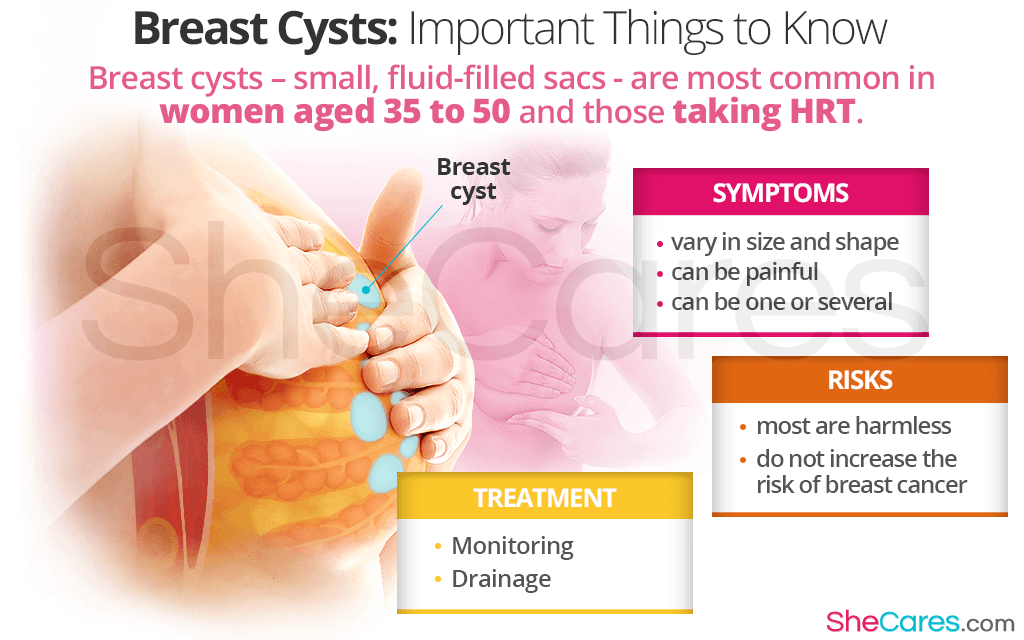As a woman journeys through life, her breasts are likely to encounter many changes in shape, size, and composition. While these changes are natural and somewhat expected, discovering a breast cyst can understandably cause panic. The good news is that breast cysts are common and largely non-threatening.
Read on to find out the most important things to know about breast cysts, including what they are, what do they mean for your health, what symptoms they produce, and how to treat them for ultimate relief.
What Is a Breast Cyst?
A breast cyst is a small lump or sac that is filled with fluid. They are not cancerous and do not pose other health threats.
Cysts in the breasts occur when the glands within them are blocked and fluid absorption is compromised, leading to a build-up. While they are affected by hormonal fluctuations, science is unclear as to why some women are more prone to their development than others.
Are Breast Cysts Dangerous?
Unsurprisingly, the first concern of most women upon discovering a lump in the breast is whether it is cancer.
Fortunately, the likelihood of a cyst being cancerous is extremely low. Studies have shown that breast cysts do not put women at a higher risk of developing breast cancer.1
Although some breast cysts can only be detected through imaging, it is important to perform self-breast exams regularly and consult any breast changes with one's doctor upon their discovery. After all, women are the ones who know their body the best and can spot any changes the fastest.
How Common Are Breast Cysts?
Breast cysts are very common. They are most often seen in women aged between 35 and 50 and in menopausal women who use hormone replacement therapy (HRT).2
However, cysts in the breast can appear in women of all ages and at various reproductive stages.
Breast Cyst Symptoms
Breast cysts can vary in shape, size, and other characteristics. Nevertheless, most common symptoms are as follows:
- Most are very small, less than half an inch in diameter
- Some feel soft and pliable, others might be firm
- Usually are oval or round
- Can move freely within the breast
- Can cause breast tenderness
- Can be painful and get bigger, especially around monthly menses
- There might be several of them in one breast
Breast Cyst Treatment
There are two approaches to breast cyst treatment, monitoring and drainage, depending on their size and symptoms they produce.
Monitoring. Since breast cysts are harmless, oftentimes treatment is not necessary. If they are not producing symptoms, a woman's doctor will likely monitor them over time.
Drainage. Large or painful cysts might be better off drained, which is done with a long and thin needle. Once drained, the cyst collapses and disappears. It can, however, regrow in the future.
When Should I Be Worried?
Women are advised to monitor their breasts and immediately report to their doctor any of the following changes:
- Persistent pain
- Swelling
- Irritation around the nipple
- Nipple discharge
- Nipple retraction
- Skin changes, such as redness, dimpling, or itchiness
- Changes in color, size, or shape of the breasts
Conclusions
Finding a breast cyst can be unsettling, but armed with knowledge, women should rest assured that they usually do not present a threat to their health. In spite of this, it is important to stay vigilant about one's health and put efforts into maintaining hormonal equilibrium. This can be achieved with wholesome lifestyle adjustments of a nutritious diet, regular exercise, and stress-relief techniques alongside safe and effective alternative medicine. Click on the following link to discover the best hormonal imbalance treatments for a symptom-free life for years to come!
Sources
- American Cancer Society. (2019). Fibrosis and Simple Cysts in the Breast. Retrieved December 2, 2019 from https://www.cancer.org/cancer/breast-cancer/non-cancerous-breast-conditions/fibrosis-and-simple-cysts-in-the-breast.html
- Breast Cancer Foundation NZ. (n.d.). Benign breast conditions. Retrieved December 2, 2019 from https://www.breastcancerfoundation.org.nz/breast-awareness/breast-changes/benign-breast-conditions
- John Hopkins Medicine. (n.d.). Common Benign Lumps. Retrieved December 2, 2019 from https://www.hopkinsmedicine.org/health/conditions-and-diseases/common-benign-lumps
- Mayo Clinic. (2018). Breast cysts. Retrieved November 2, 2019 from https://www.mayoclinic.org/diseases-conditions/breast-cysts/symptoms-causes/syc-20370284
- National Breast Cancer Foundation. (n.d.). Breast Cyst. Retrieved December 2, 2019 from https://www.nationalbreastcancer.org/cyst-in-breast
Footnotes:
- Breast Cancer Now. (n.d.). Breast cysts. December 2, 2019 from https://breastcancernow.org/information-support/have-i-got-breast-cancer/breast-pain-other-benign-conditions/breast-cysts
- Health Direct. (2018). Breast cysts. Retrieved November 2, 2019 from https://www.healthdirect.gov.au/breast-cysts
